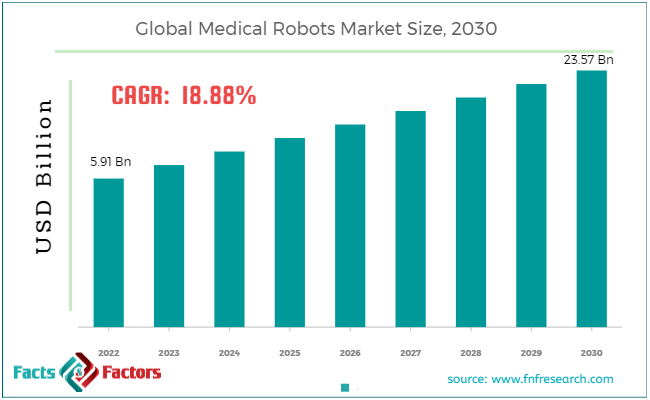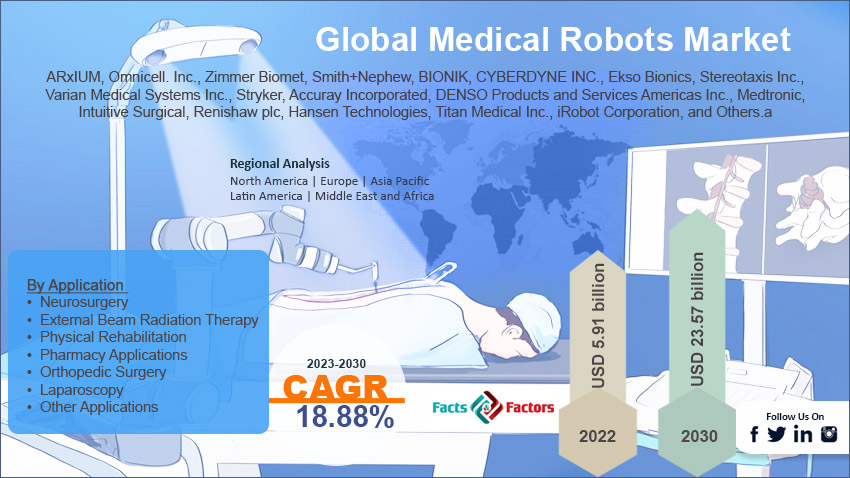Search Market Research Report
Medical Robots Market Size, Share Global Analysis Report, 2023 – 2030

Medical Robots Market Size, Share, Growth Analysis Report By Product & Services (Services, Robotic systems, And Instruments & Accessories), By Application (Neurosurgery, External Beam Radiation Therapy, Physical Rehabilitation, Pharmacy Applications, Orthopedic Surgery, Laparoscopy, And Other Applications), By End-User (Rehabilitation Centers, Ambulatory Surgery Centers, Hospitals, And Others), And By Region - Global and Regional Industry Insights, Overview, Comprehensive Analysis, Trends, Statistical Research, Market Intelligence, Historical Data and Forecast 2023 – 2030
Industry Insights
[221+ Pages Report] According to Facts and Factors, the global medical robots market size was valued at USD 5.91 billion in 2022 and is predicted to surpass USD 23.57 billion by the end of 2030. The medical robots industry is expected to grow by a CAGR of 18.88%.

 Market Overview
Market Overview
Medical robots refer to the specialized robotic systems used for different medical purposes like telepresence, rehabilitation surgeries, diagnoses, and several other applications. These robots are manufactured with sophisticated technologies to help surgeons in different surgical procedures. These robots help improve precision, extend the capabilities of medical procedures, and offer improved patient care.
 Key Insights
Key Insights
- As per the analysis shared by our research analyst, the global medical robots market size is estimated to grow annually at a CAGR of around 18.88% over the forecast period (2023-2030).
- In terms of revenue, the global medical robots market size was valued at around USD 5.91 billion in 2022 and is projected to reach USD 23.57 billion by 2030.
- Surging trend of minimally invasive surgeries is driving the growth of the global medical robots market.
- Based on the product & services, the instruments and accessories segment is growing at a high rate and is projected to dominate the global market.
- Based on the application, the laparoscopy application segment is projected to swipe the largest market share.
- Based on the end-user, the hospital segment is expected to dominate the global market.
- Based on region, Asia Pacific is expected to dominate the global market during the forecast period.

 Growth Drivers
Growth Drivers
- Surging trend of minimally invasive surgeries is driving the growth of the global market.
There is an increasing demand for the minimal surgical procedure in the global marketplace. Robots help healthcare professionals execute simple and complex surgeries with small incisions, thereby facilitating faster recovery, less trauma, and high success rates.
Also, the continuous advancements in robotic automation and artificial intelligence are further contributing to the growth of the global medical robots market. These robots offer better imaging capabilities, improved precision, and better user interfaces, which further attract people.
For instance, Medtronic successfully took over Medicrea in 2020. It is a leading organization in the transformation of spinal surgery with the help of patient-specific implants, predictive modeling, and artificial intelligence.
 Restraints
Restraints
- High initial cost is likely to hamper the growth of the global market.
The high upfront cost associated with medical robotic systems is a big barrier in the global market. The cost of purchasing equipment, training the healthcare staff, and integrating technology into the legacy infrastructure involves huge investment, which deters price-sensitive consumers, thereby limiting the growth of medical robots in the global marketplace.
 Opportunities
Opportunities
- Fast regulatory approvals are expected to foster growth opportunities in the global market.
A clear regulatory framework helps manufacturers get approval for new medical reports more easily. This conducive environment is expected to widen the scope of the global medical robots market in the forthcoming years.
Also, the governments have established standards for safety and efficacy, which help manufacturers get more sales. These regulatory standards foster a sense of confidence in the healthcare providers and patients regarding the medical robot systems.
For instance, Stryker Corporation successfully took over Cardan Robotics and Mobius Imaging LLC in 2019. The acquisition is likely to come up with advanced imaging and robotics.
 Challenges
Challenges
- Lack of reimbursement policies is a big challenge in the global market.
Inadequate reimbursement policies limit the adoption of medical robots in many regions. Investments in the healthcare and pharmaceutical sectors need financial support, but the lack of such policies is a big challenge in the medical robots industry.
 Segmentation Analysis
Segmentation Analysis
The global medical robots market can be segmented into products & services, application, end-user, and region.
By product & services, the market can be segmented into services, robotic systems, and instruments & accessories. The instruments and accessories segment is likely to swipe a larger market area in the forthcoming years. The advancements in the robotic sector are driving the innovation of mass-sophisticated instruments and accessories. These specialized instruments help healthcare providers in upgrading their robotic systems with state-of-the-art devices.
Also, the scope of medical robots is expanding vigorously, leaving behind traditional surgical procedures. These robots are widely being adopted for rehabilitative, therapeutic, and diagnostic roles. Moreover, the surging trend of adopting minimally invasive procedures is also likely to be a major driver for the growth of the segment. Surgical robots are highly employed in these kinds of surgeries, which help in fast recovery times, shorter hospital stays, and reduced pain, thereby making them more appealing to both patients and healthcare providers.
By application, the market can be segmented into neurosurgery, external beam radiation therapy, physical rehabilitation, pharmacy applications, orthopedic surgery, laparoscopy, and other applications. The laparoscopy application segment is poised to witness significant developments in the global medical robots market. The growing demand for minimally invasive surgeries is driving the growth of laparoscopic procedures. The laparoscopic procedures help in reducing trauma, shorter hospital stays, and post-operative pain.
Also, the diversifying applications of laparoscopy are now expanding to various specialties like gastrointestinal, urological, gynecological, and other surgeries. Such versatility and high capability of robotic systems assist in diverse procedures, which is further expected to positively impact the growth trajectory of the segment during the forecast period.
By end users, the market can be segmented into rehabilitation centers, ambulatory surgery centers, hospitals, and others. The hospital segment accounts for the largest share of the medical robots industry. Hospitals have well-established healthcare infrastructure to help people with advanced medical procedures like diagnostics and surgeries. Hospitals are increasingly adopting medical robotic systems and automation technologies to improve the precision and efficiency of their surgical procedures.
Also, hospitals are witnessing an increasing demand for minimally invasive surgeries, which is further encouraging the centers to adopt robotic technology and facilitate invasive procedures. Hospitals are increasingly investing in medical robots to stay competitive in the global marketplace.
Moreover, the high success rate and improved patient outcomes in hospitals are further contributing to the growth of the segment. Hospitals also get higher traction among patients because of their cost-effectiveness. Hospitals offer cost-effective surgeries with lower complication rates, long-term benefits, and lower hospitalization duration.
Therefore, the people prefer to adopt the minimally invasive procedures in the hospitals. Such a landscape is likely to foster developments in the segment in the forthcoming years.
 Report Scope
Report Scope
Report Attribute |
Details |
Market Size in 2022 |
USD 5.91 Billion |
Projected Market Size in 2030 |
USD 23.57 Billion |
CAGR Growth Rate |
18.88% CAGR |
Base Year |
2022 |
Forecast Years |
2023-2030 |
Key Market Players |
ARxIUM, Omnicell. Inc., Zimmer Biomet, Smith+Nephew, BIONIK, CYBERDYNE INC., Ekso Bionics, Stereotaxis Inc., Varian Medical Systems Inc., Stryker, Accuray Incorporated, DENSO Products and Services Americas Inc., Medtronic, Intuitive Surgical, Renishaw plc, Hansen Technologies, Titan Medical Inc., iRobot Corporation, and Others. |
Key Segment |
By Product & Services, By Application, By End-User, and Region |
Major Regions Covered |
North America, Europe, Asia Pacific, Latin America, and the Middle East &, Africa |
Purchase Options |
Request customized purchase options to meet your research needs. Explore purchase options |
 Regional Analysis
Regional Analysis
- Asia Pacific to dominate the global market
Asia Pacific accounts for the largest share of the global medical robots market because of the rising disposable income of people along with increasing urbanization. Governments in the region are boosting their investments in the healthcare sector to improve infrastructure and services. Such initiatives are leading to advancements in medical technology, like medical robots, which help improve patient care treatment and increase the success rate.
Asia Pacific is witnessing a significant demographic shift. The region is expected to see a surge in the aging population, thereby posing a huge demand for medical robots that could further help in the treatment of age-related disorders and surgeries. The region is also witnessing growing investments from local companies along with foreign direct investments because of the increasing scope of medical robotic systems in the region.
Surgical robots are expanding their capabilities in various specialties, which is further supporting their adoption in hospitals and healthcare institutes across the region. Rapidly emerging economies like India, South Korea, and China are further expected to contribute heavily towards regional revenue because these nations are providing a substantial market for medical robot systems.
North America is also likely to witness huge growth in the coming years because of the increasing research and development activities in the region. Healthcare institutes are collaborating with technology companies to come up with sophisticated medical robotic systems. Surgical robots are gaining immense traction in the region because of their increasing utilization in different surgical procedures. Surgeons are using these robots because of their high precision and the benefits associated with robotic-assisted surgery.
Also, the increasing investments in healthcare facilities in the region, like the upgradation of operating rooms and surgical suits and the facilitation of better integration of medical robots, are likely to positively impact the growth trajectory of the regional market. For instance, Accuracy came up with the CyberKnife S7 system in the year 2020. It is a next-generation CyberKnife platform with real-time artificial intelligence and advanced precision.
 Competitive Analysis
Competitive Analysis
The key players in the global medical robots market include:
- ARxIUM
- Omnicell. Inc.
- Zimmer Biomet
- Smith+Nephew
- BIONIK
- CYBERDYNE INC.
- Ekso Bionics
- Stereotaxis Inc.
- Varian Medical Systems Inc.
- Stryker
- Accuray Incorporated
- DENSO Products and Services Americas Inc.
- Medtronic
- Intuitive Surgical
- Renishaw plc
- Hansen Technologies
- Titan Medical Inc.
- iRobot Corporation
For instance, Stryker Corporation got approval for the MAKO robotic surgery system in 2020 in Japan for the purpose of making partial knee indications.
The global medical robots market is segmented as follows:
 By Product & Services Segment Analysis
By Product & Services Segment Analysis
- Services
- Robotic systems
- Instruments & Accessories
 By Application Segment Analysis
By Application Segment Analysis
- Neurosurgery
- External Beam Radiation Therapy
- Physical Rehabilitation
- Pharmacy Applications
- Orthopedic Surgery
- Laparoscopy
- Other Applications
 By End-User Segment Analysis
By End-User Segment Analysis
- Rehabilitation Centers
- Ambulatory Surgery Centers
- Hospitals
- Others
 By Regional Segment Analysis
By Regional Segment Analysis
- North America
- The U.S.
- Canada
- Mexico
- Europe
- France
- The UK
- Spain
- Germany
- Italy
- Rest of Europe
- Asia Pacific
- China
- Japan
- India
- Australia
- Southeast Asia
- Rest of Asia Pacific
- The Middle East & Africa
- Saudi Arabia
- UAE
- Egypt
- Kuwait
- South Africa
- Rest of the Middle East & Africa
- Latin America
- Brazil
- Argentina
- Rest of Latin America
Industry Major Market Players
Frequently Asked Questions

Copyright © 2024 - 2025, All Rights Reserved, Facts and Factors


